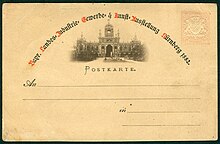Johann Baptist Obernetter
Johann Baptist Obernetter (born May 31, 1840 in Munich ; † April 12, 1887 there ) was a German chemist , photo chemist and printer . He is considered the inventor of collotype .
Life
Johann Baptist Obernetter studied chemistry at the University of Leipzig and the University of Heidelberg , became an assistant to Justus von Liebig , joined Joseph Albert's Munich studio in 1860 and invented a process for burning photographs on porcelain, enamel and glass, and in 1868 collodion paper .
In 1869, Obernetter founded his own company and turned to collotype printing and gave it the shape that was carried out under the name of Albertotype . He later improved the collotype significantly by using the dusting process using graphite . In 1873 he had 22 employees, operated 10 printing presses and produced collodion paper .

1882 in Nuremberg , signed J. B. Obernetter
From 1880 to 1882, Obernetter worked on improving drying plates and color collotype printing, and he also invented a process for producing a second negative of any size from a negative in the camera himself by means of development. In 1884 he invented a new method of photo engraving , which afforded the advantage of a real facsimile reproduction without retouching . With the photo chemist Hermann Wilhelm Vogel , he worked on orthochromatic processes that delivered images of colored objects in the correct tonal value , and in doing so came to the eosin and erythrosine silver plates.
Works and developments
- Johann Baptist Obernetter: About photographic copier methods without silver salts. In: Polytechnisches Journal . 172, 1864, pp. 135-139.
- Obernetter's email process . In: Photographisches Archiv , Vol. 6, Theobald Grieben, Berlin, 1865, pp. 382–383.
- Obernetter's glass print . In: Photographisches Archiv , Volume 10, Theobald Grieben, Berlin 1869, pp. 265–266.
literature
- Obernetter, Johann Baptist . In: Meyers Großes Konversations-Lexikon . 6th edition. Volume 14, Bibliographisches Institut, Leipzig / Vienna 1908, p. 867 .
- Nekrolog in: Yearbook for Photography and Reproduction Technology for the year 1888, 2nd year, Wilhelm Knapp, Halle / S. 1888, p. 440.
- Hans von Berlepsch : Biographische Mittheilungen , in Lepoldina , Mitteilungen der Deutsche Akademie der Naturforscher Leopoldina, Volume 23, Halle / S., 1887, p. 110
- Ludwig cabinet: Johann Baptist Obernetter † , Nekrolog. In: Photographische Korrespondenz , Volume 24. Verlag der Photographische Korrespondenz, Vienna / Leipzig 1887, p. 215 f.
Web links
- Johann Baptist Obernetter in the German biography
- Photographs by Johann Baptist Obernetter at zeno.org
- CERL Thesaurus digitized and digitized
- Johann Baptist Obernetter at Europeana .eu
References and comments
- ↑ a b Meyer's Large Conversation Lexicon
- ↑ Different date of death April 13, 1887; see Nekrolog von L. Cabinet in Photographic Correspondence .
- ^ NN: Vienna World Exhibition , Official Catalog of the Exhibition of the German Empire , Berlin, 1873, p. 440.
| personal data | |
|---|---|
| SURNAME | Obernetter, Johann Baptist |
| ALTERNATIVE NAMES | Obernetter, JB; Obernetter, Johann; Obernetter, Johann B. |
| BRIEF DESCRIPTION | German chemist, photo chemist and printer |
| DATE OF BIRTH | May 31, 1840 |
| PLACE OF BIRTH | Munich |
| DATE OF DEATH | April 12, 1887 |
| Place of death | Munich |
